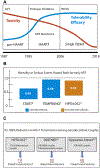Why Everyone (Almost) with HIV Needs to Be on Treatment: A Review of the Critical Data
- PMID: 31248703
- PMCID: PMC8544606
- DOI: 10.1016/j.idc.2019.05.002
Why Everyone (Almost) with HIV Needs to Be on Treatment: A Review of the Critical Data
Abstract
Since 2014, a consensus of landmark studies has justified starting antiretroviral therapy (ART) regardless of CD4 count. The evidence for immediate and universal ART is strong, clearly showing individual and population-level benefits, and is supported by all major guidelines groups. Altogether, improvements in ART and recognition of its clinical and epidemiologic benefits justify near-universal ART, preferably as soon after the diagnosis of human immunodeficiency virus (HIV) as possible. Case-based discussions provide a framework to explore the evidence behind the current recommendation for ART for all HIV-positive persons and specific scenarios are discussed in which ART initiation may be delayed.
Keywords: AIDS; Antiretroviral therapy; CD4; Guidelines; HIV; Rapid start; Treatment as prevention.
Copyright © 2019 Elsevier Inc. All rights reserved.
Figures

References
-
- Hammer SM, Squires KE, Hughes MD, et al. A controlled trial of two nucleoside analogues plus indinavir in persons with human immunodeficiency virus infection and CD4 cell counts of 200 per cubic millimeter or less. AIDS Clinical Trials Group 320 Study Team. N Engl J Med 1997;337(11):725–33. - PubMed
-
- Gulick RM, Mellors JW, Havlir D, et al. Treatment with indinavir, zidovudine, and lamivudine in adults with human immunodeficiency virus infection and prior antiretroviral therapy. N Engl J Med 1997;337(11):734–9. - PubMed
-
- Guidelines for managing advanced HIV disease and rapid initiation of antiretroviral therapy, July 2017. World Health Organization; 2017. Available at: https://apps.who.int/iris/bitstream/handle/10665/255884/9789241550062-en.... - PubMed
-
- Department of Health and Human Services. Panel on antiretroviral guidelines for adults and adolescents. Guidelines for the use of antiretroviral agents in adults and adolescents living with HIV 2018. Available at: http://aidsinfo.nih.gov/contentfiles/lvguidelines/AdultandAdolescentGL.pdf. Accessed December 15, 2018.
Publication types
MeSH terms
Substances
Grants and funding
LinkOut - more resources
Full Text Sources
Medical
Research Materials

